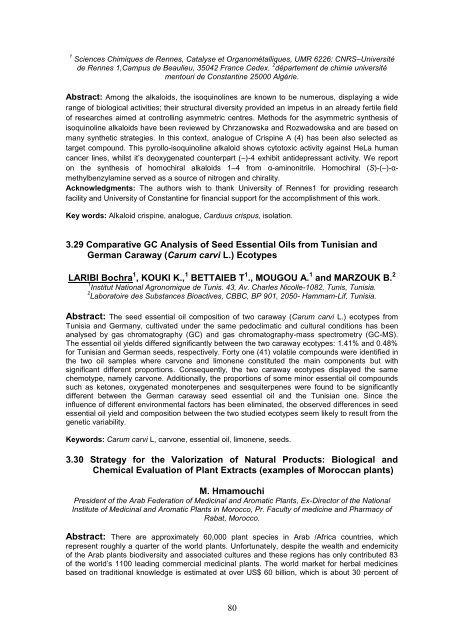Abstract Book - 3rd International Symposium on Medicinal Plants ...
Abstract Book - 3rd International Symposium on Medicinal Plants ...
Abstract Book - 3rd International Symposium on Medicinal Plants ...
You also want an ePaper? Increase the reach of your titles
YUMPU automatically turns print PDFs into web optimized ePapers that Google loves.
1 Sciences Chimiques de Rennes, Catalyse et Organométalliques, UMR 6226: CNRS–Université<br />
de Rennes 1,Campus de Beaulieu, 35042 France Cedex. 2 département de chimie université<br />
mentouri de C<strong>on</strong>stantine 25000 Algérie.<br />
<str<strong>on</strong>g>Abstract</str<strong>on</strong>g>: Am<strong>on</strong>g the alkaloids, the isoquinolines are known to be numerous, displaying a wide<br />
range of biological activities; their structural diversity provided an impetus in an already fertile field<br />
of researches aimed at c<strong>on</strong>trolling asymmetric centres. Methods for the asymmetric synthesis of<br />
isoquinoline alkaloids have been reviewed by Chrzanowska and Rozwadowska and are based <strong>on</strong><br />
many synthetic strategies. In this c<strong>on</strong>text, analogue of Crispine A (4) has been also selected as<br />
target compound. This pyrollo-isoquinoline alkaloid shows cytotoxic activity against HeLa human<br />
cancer lines, whilst it‟s deoxygenated counterpart (–)-4 exhibit antidepressant activity. We report<br />
<strong>on</strong> the synthesis of homochiral alkaloids 1–4 from α-amin<strong>on</strong>itrile. Homochiral (S)-(–)-αmethylbenzylamine<br />
served as a source of nitrogen and chirality.<br />
Acknowledgments: The authors wish to thank University of Rennes1 for providing research<br />
facility and University of C<strong>on</strong>stantine for financial support for the accomplishment of this work.<br />
Key words: Alkaloid crispine, analogue, Carduus crispus, isolati<strong>on</strong>.<br />
3.29 Comparative GC Analysis of Seed Essential Oils from Tunisian and<br />
German Caraway (Carum carvi L.) Ecotypes<br />
LARIBI Bochra 1 , KOUKI K., 1 BETTAIEB T 1 ., MOUGOU A. 1 and MARZOUK B. 2<br />
1 Institut Nati<strong>on</strong>al Agr<strong>on</strong>omique de Tunis. 43, Av. Charles Nicolle-1082, Tunis, Tunisia.<br />
2 Laboratoire des Substances Bioactives, CBBC, BP 901, 2050- Hammam-Lif, Tunisia.<br />
<str<strong>on</strong>g>Abstract</str<strong>on</strong>g>: The seed essential oil compositi<strong>on</strong> of two caraway (Carum carvi L.) ecotypes from<br />
Tunisia and Germany, cultivated under the same pedoclimatic and cultural c<strong>on</strong>diti<strong>on</strong>s has been<br />
analysed by gas chromatography (GC) and gas chromatography-mass spectrometry (GC-MS).<br />
The essential oil yields differed significantly between the two caraway ecotypes: 1.41% and 0.48%<br />
for Tunisian and German seeds, respectively. Forty <strong>on</strong>e (41) volatile compounds were identified in<br />
the two oil samples where carv<strong>on</strong>e and lim<strong>on</strong>ene c<strong>on</strong>stituted the main comp<strong>on</strong>ents but with<br />
significant different proporti<strong>on</strong>s. C<strong>on</strong>sequently, the two caraway ecotypes displayed the same<br />
chemotype, namely carv<strong>on</strong>e. Additi<strong>on</strong>ally, the proporti<strong>on</strong>s of some minor essential oil compounds<br />
such as ket<strong>on</strong>es, oxygenated m<strong>on</strong>oterpenes and sesquiterpenes were found to be significantly<br />
different between the German caraway seed essential oil and the Tunisian <strong>on</strong>e. Since the<br />
influence of different envir<strong>on</strong>mental factors has been eliminated, the observed differences in seed<br />
essential oil yield and compositi<strong>on</strong> between the two studied ecotypes seem likely to result from the<br />
genetic variability.<br />
Keywords: Carum carvi L, carv<strong>on</strong>e, essential oil, lim<strong>on</strong>ene, seeds.<br />
3.30 Strategy for the Valorizati<strong>on</strong> of Natural Products: Biological and<br />
Chemical Evaluati<strong>on</strong> of Plant Extracts (examples of Moroccan plants)<br />
M. Hmamouchi<br />
President of the Arab Federati<strong>on</strong> of <strong>Medicinal</strong> and Aromatic <strong>Plants</strong>, Ex-Director of the Nati<strong>on</strong>al<br />
Institute of <strong>Medicinal</strong> and Aromatic <strong>Plants</strong> in Morocco, Pr. Faculty of medicine and Pharmacy of<br />
Rabat, Morocco.<br />
<str<strong>on</strong>g>Abstract</str<strong>on</strong>g>: There are approximately 60,000 plant species in Arab /Africa countries, which<br />
represent roughly a quarter of the world plants. Unfortunately, despite the wealth and endemicity<br />
of the Arab plants biodiversity and associated cultures and these regi<strong>on</strong>s has <strong>on</strong>ly c<strong>on</strong>tributed 83<br />
of the world‟s 1100 leading commercial medicinal plants. The world market for herbal medicines<br />
based <strong>on</strong> traditi<strong>on</strong>al knowledge is estimated at over US$ 60 billi<strong>on</strong>, which is about 30 percent of<br />
80

















